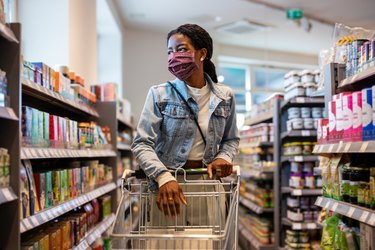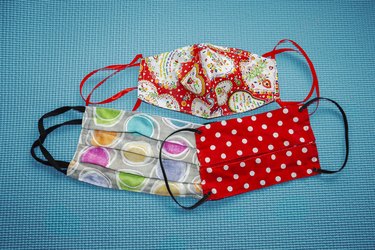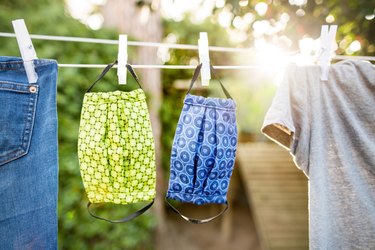
The Centers for Disease Control and Prevention (CDC) has relaxed some mask-wearing guidelines for vaccinated people, but face masks are still a fact of everyday life. And for good reason: Face coverings are the most effective tactic for blocking the spread of COVID-19, according to a June 2020 analysis in the Proceedings of the National Academy of Sciences.
While nonmedical-grade, disposable masks are a viable option, you might be thinking about investing in a reusable cloth face covering (or making one of your own). That way, you can wear a mask that suits your style (and avoid adding to landfills).
Video of the Day
Video of the Day
But not all masks are created equally. With a plethora of options on the market, how do you know which cloth face covering will offer the best protection for you and others?
We consulted Jade Flinn, MSN, RN, an expert on best practices for infection prevention and nurse educator for the Johns Hopkins Biocontainment Unit, to learn about what features to consider when buying a cloth face mask. She also shares tips on ways to wash and properly care for your reusable face coverings.
Get tips on how to stay healthy, safe and sane during the novel coronavirus pandemic.
What to Look for in a Cloth Face Mask

Remember, COVID-19 spreads primarily through respiratory droplets (produced when you talk, cough, sneeze and breathe) that find their way into the mouths or noses of others nearby, per the Centers for Disease Control and Prevention (CDC).
Tip
Wearing a mask helps safeguard people around you. But they're not a replacement for social distancing, per the CDC — if you're unvaccinated, continue to maintain 6 feet of distance from others when you're in public.
In a June 2020 lab experiment published in Physics of Fluids, researchers measured how far respiratory droplets travel when wearing a variety of different types of face coverings. To do so, they emulated coughs using mannequins. When a mannequin's mouth opening was uncovered, aerosolized droplets traveled an average of 8 feet and as far as 12 feet, according to the study.
A homemade, stitched cloth face mask made from two layers of quilting cotton reduced that distance to 2.5 inches, while a store-bought mask kept the spray to an average of 8 inches. Folded handkerchiefs and tied bandanas were less effective, reducing droplet travel to about a foot and 3 feet, respectively.
While more research is needed, this paints a picture of the importance of considering fabric type and durability. But you also need to pay attention to mask fit to help contain the transmission of these disease-carrying droplets, Flinn tells LIVESTRONG.com. Keep these considerations in mind.
Fabric Face Masks to Buy
- Auliné Collection Reusable Face Mask ($7.99 from Amazon)
- NxTSTOP Bamboo Face Mask ($14 from TheNxTSTOP)
- Baggu Fabric Mask Set ($32 for 3 from Baggu)
1. Made With a Tightly Woven Fabric
Look for masks made from fabrics with a tight weave, like cotton. This allows the mask to better inhibit both large and smaller droplets from escaping your face covering, Flinn says. (Cotton is also easy to clean, she adds.)
Quilting cotton was the most effective material in reducing droplet travel in the Physics of Fluids study. The folded handkerchief used in the experiment was also made of cotton, but with a lower thread count.
However, a higher thread count isn't always better: The bandana that was tested was made out of an elastic T-shirt material that had the highest thread count of the experiment, but it was the least effective face covering studied.
Of the everyday fabrics you might find in your home, tea towels, antimicrobial pillow cases and cotton-blend fabric were most effective at offering protection, per a June 2020 study in the Journal of Hospital Infection.
For this study, researchers examined the effectiveness of various mask materials at preventing infection over time, during 30-second and 20-minute exposures to the virus. Using scarves and T-shirts as masks was only slightly more effective than going without one, per the researchers — over a 20-minute exposure, a scarf reduced infection risk by 24 percent and by 44 percent over a 30-second exposure.
2. Has at Least 2 Layers
Flinn recommends masks made with several layers of fabric. "Multiple layers are more likely to be more effective in containing the spread of droplets," she explains.
The CDC recommends choosing masks with at least two layers of fabric.
Some masks even have small pockets where you can place a filter for an extra barrier of protection. If you choose to go this route, you can purchase a filter online or use household staples like coffee filters and paper towels, which can serve as face mask filters.
Another good option: vacuum cleaner filters. Using these in the filter pocket of a cloth mask reduced infection risk by 83 percent for a 30-second exposure and 58 percent over a 20-minute exposure, per the Journal of Hospital Infection study.
Tip
Always discard and replace filters after each use.
3. Fits Snugly to Your Face
Prioritizing proper fit is also important when purchasing or making a mask, Flinn says. Your mask should fit snugly around your face and provide full coverage over both your nose and mouth. "Mask coverings with ties around the head may slip over time and cause gaps in fit," she says.
Homemade masks are often a bit too loose-fitting, according to the Physics of Fluids study, leading to a fair amount of leakage of respiratory droplets out of the top of the mask. In the experiment, those leaked droplets traveled around 3 to 6 inches.
You'll also want to ensure that you can easily breathe while wearing your mask, according to the WHO. If you can't, you may find yourself tempted to remove it.
Bottom Line
It might take a little trial and error to find a cloth face mask with the perfect combination of complete coverage and comfort for periods of prolonged wearing.
2 Things to Avoid in Cloth Face Masks
1. Bandanas and Neck Gaiters
A bandana or neck gaiter (aka a neck warmer or neck fleece) — which rests around the neck and can be rolled upward to cover the face — may look similar to other cloth face coverings. But while they can be rigged to cover the mouth and nose, bandanas and neck gaiters are not effective at blocking respiratory droplets, per an August 2020 study published in Science Advances.
For the study, a person spoke in the direction of a box rigged with a laser beam and camera while wearing a face covering. The droplets in the resulting video were counted. Bandanas and neck gaiters allowed the most droplets to escape, while professionally fitted N95 masks, surgical masks and cotton cloth face masks were the most successful at stopping droplets out of the 14 types of face coverings examined in the study.
Bottom line: To prevent the spread of COVID-19, avoid wearing bandanas and neck gaiters. That's true for neck gaiters in particular, which led to large droplets dispersing into smaller ones — since these smaller droplets stay aloft longer, "the use of such a mask might be counterproductive," per the study.
2. Exhalation Valves or Vents
You may see fabric face masks available with an exhalation valve or vent that allows your breath to exit the mask. Stay away from face coverings that have this ill-advised feature, per the CDC. Wearing a mask that allows respiratory droplets out will not prevent the spread of the novel coronavirus, defeating the point of donning a mask.
How to Wash and Disinfect Your Cloth Mask

Once you no longer need to wear your mask, carefully remove it with clean hands, touching only the ties, per the WHO. Clean your hands again after removing the mask, according to the CDC.
In the Washing Machine
"Aim to wash cloth face coverings daily [i.e., after every use] with normal detergent in a washing machine," Flinn says. If you don't plan to do laundry more than once a week, you'll want to stock up on or make enough masks to wear a clean one for every outing.
And, in case you're wondering, it's fine to toss your mask in with a load of your regular laundry, according to the CDC; just make sure you're using the warmest possible water setting that won't ruin the fabric.
Washing by Hand
"If you choose to handwash, soak, scrub [for at least 20 seconds] and rinse your cloth mask thoroughly with hot water and soap," Flinn says.
Disinfecting With Bleach
Alternatively, you can disinfect by soaking your face covering in a bleach solution. Mix 5 tablespoons of household bleach per gallon of room temperature water or 4 teaspoons per quart. Soak for 5 minutes, then rinse thoroughly with cool water, per the CDC.
Disinfecting With Chlorine
Another way to wash your mask by hand is to soak it for one minute in 0.1 percent chlorine, accordingly to the WHO. After the mask has soaked, use room temperature water to rinse away all of the chlorine.
Drying Face Masks
Once your mask is washed, you'll need to dry it. To do so, "use the highest heat dryer setting, or if air drying, place your mask in direct sunlight, which can also help disinfect viral particles," Flinn says.
Concerned About COVID-19?
Read more stories to help you navigate the novel coronavirus pandemic:
- PNAS: “Identifying airborne transmission as the dominant route for the spread of COVID-19.”
- Centers for Disease Control and Prevention: “How to Wash Cloth Face Coverings.”
- Centers for Disease Control and Prevention: "How COVID-19 Spreads."
- Centers for Disease Control and Prevention: "How to Protect Yourself & Others"
- World Health Organization: "Advice on the Use of Masks in the Context of COVID-19"
- World Health Organization: "Q&A: Masks and COVID-19"
- Centers for Disease Control and Prevention: "How to Wear Cloth Face Coverings"
- Physics of Fluid: "Visualizing the effectiveness of face masks in obstructing respiratory jets"
- The Journal of Hospital Infection: "COVID-19 and non-traditional mask use: How do various materials compare in reducing the infection risk for mask wearers?"
- CDC: "Your Guide to Masks"
- Science Advances: "Low-cost measurement of facemask efficacy for filtering expelled droplets during speech"
- Centers for Disease Control and Prevention: "When You’ve Been Fully Vaccinated"
Is this an emergency? If you are experiencing serious medical symptoms, please see the National Library of Medicine’s list of signs you need emergency medical attention or call 911.